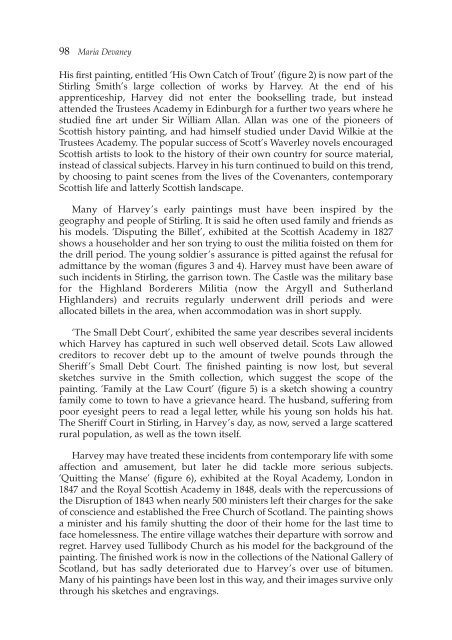the Forth Naturalist Historian - Forth Naturalist and Historian ...
the Forth Naturalist Historian - Forth Naturalist and Historian ...
the Forth Naturalist Historian - Forth Naturalist and Historian ...
You also want an ePaper? Increase the reach of your titles
YUMPU automatically turns print PDFs into web optimized ePapers that Google loves.
98 Maria Devaney<br />
His first painting, entitled ‘His Own Catch of Trout’ (figure 2) is now part of <strong>the</strong><br />
Stirling Smith’s large collection of works by Harvey. At <strong>the</strong> end of his<br />
apprenticeship, Harvey did not enter <strong>the</strong> bookselling trade, but instead<br />
attended <strong>the</strong> Trustees Academy in Edinburgh for a fur<strong>the</strong>r two years where he<br />
studied fine art under Sir William Allan. Allan was one of <strong>the</strong> pioneers of<br />
Scottish history painting, <strong>and</strong> had himself studied under David Wilkie at <strong>the</strong><br />
Trustees Academy. The popular success of Scott’s Waverley novels encouraged<br />
Scottish artists to look to <strong>the</strong> history of <strong>the</strong>ir own country for source material,<br />
instead of classical subjects. Harvey in his turn continued to build on this trend,<br />
by choosing to paint scenes from <strong>the</strong> lives of <strong>the</strong> Covenanters, contemporary<br />
Scottish life <strong>and</strong> latterly Scottish l<strong>and</strong>scape.<br />
Many of Harvey’s early paintings must have been inspired by <strong>the</strong><br />
geography <strong>and</strong> people of Stirling. It is said he often used family <strong>and</strong> friends as<br />
his models. ‘Disputing <strong>the</strong> Billet’, exhibited at <strong>the</strong> Scottish Academy in 1827<br />
shows a householder <strong>and</strong> her son trying to oust <strong>the</strong> militia foisted on <strong>the</strong>m for<br />
<strong>the</strong> drill period. The young soldier’s assurance is pitted against <strong>the</strong> refusal for<br />
admittance by <strong>the</strong> woman (figures 3 <strong>and</strong> 4). Harvey must have been aware of<br />
such incidents in Stirling, <strong>the</strong> garrison town. The Castle was <strong>the</strong> military base<br />
for <strong>the</strong> Highl<strong>and</strong> Borderers Militia (now <strong>the</strong> Argyll <strong>and</strong> Su<strong>the</strong>rl<strong>and</strong><br />
Highl<strong>and</strong>ers) <strong>and</strong> recruits regularly underwent drill periods <strong>and</strong> were<br />
allocated billets in <strong>the</strong> area, when accommodation was in short supply.<br />
‘The Small Debt Court’, exhibited <strong>the</strong> same year describes several incidents<br />
which Harvey has captured in such well observed detail. Scots Law allowed<br />
creditors to recover debt up to <strong>the</strong> amount of twelve pounds through <strong>the</strong><br />
Sheriff’s Small Debt Court. The finished painting is now lost, but several<br />
sketches survive in <strong>the</strong> Smith collection, which suggest <strong>the</strong> scope of <strong>the</strong><br />
painting. ‘Family at <strong>the</strong> Law Court’ (figure 5) is a sketch showing a country<br />
family come to town to have a grievance heard. The husb<strong>and</strong>, suffering from<br />
poor eyesight peers to read a legal letter, while his young son holds his hat.<br />
The Sheriff Court in Stirling, in Harvey’s day, as now, served a large scattered<br />
rural population, as well as <strong>the</strong> town itself.<br />
Harvey may have treated <strong>the</strong>se incidents from contemporary life with some<br />
affection <strong>and</strong> amusement, but later he did tackle more serious subjects.<br />
‘Quitting <strong>the</strong> Manse’ (figure 6), exhibited at <strong>the</strong> Royal Academy, London in<br />
1847 <strong>and</strong> <strong>the</strong> Royal Scottish Academy in 1848, deals with <strong>the</strong> repercussions of<br />
<strong>the</strong> Disruption of 1843 when nearly 500 ministers left <strong>the</strong>ir charges for <strong>the</strong> sake<br />
of conscience <strong>and</strong> established <strong>the</strong> Free Church of Scotl<strong>and</strong>. The painting shows<br />
a minister <strong>and</strong> his family shutting <strong>the</strong> door of <strong>the</strong>ir home for <strong>the</strong> last time to<br />
face homelessness. The entire village watches <strong>the</strong>ir departure with sorrow <strong>and</strong><br />
regret. Harvey used Tullibody Church as his model for <strong>the</strong> background of <strong>the</strong><br />
painting. The finished work is now in <strong>the</strong> collections of <strong>the</strong> National Gallery of<br />
Scotl<strong>and</strong>, but has sadly deteriorated due to Harvey’s over use of bitumen.<br />
Many of his paintings have been lost in this way, <strong>and</strong> <strong>the</strong>ir images survive only<br />
through his sketches <strong>and</strong> engravings.



